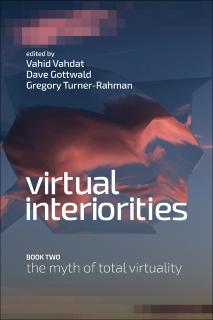Bitte benutzen Sie diese Kennung, um auf die Ressource zu verweisen:
https://doi.org/10.21256/zhaw-26795| Publikationstyp: | Buchbeitrag |
| Art der Begutachtung: | Peer review (Publikation) |
| Titel: | The mirror chiasm : problematizing embeddedness in video games through mirrors |
| Autor/-in: | Gerber, Andri |
| et. al: | No |
| DOI: | 10.21256/zhaw-26795 |
| Erschienen in: | Virtual interiorities book two: the myth of total virtuality |
| Herausgeber/-in des übergeordneten Werkes: | Vahdat, Vahid Gottwald, Dave Turner-Rahman, Gregory |
| Seite(n): | 43 |
| Seiten bis: | 59 |
| Erscheinungsdatum: | 2022 |
| Verlag / Hrsg. Institution: | Carnegie Mellon University: ETC Press |
| Verlag / Hrsg. Institution: | Pittsburgh |
| ISBN: | 978-1-387-50501-2 |
| Sprache: | Englisch |
| Schlagwörter: | Virtuelle Realität; Spiegel; Video Game; Videospiel |
| Fachgebiet (DDC): | 302.23: Medien 700: Künste und Unterhaltung |
| Zusammenfassung: | Human societies have been obsessed with evading the boundaries of the physical world, through myths and magic. Mirrors and the effect of mirroring have played a major role in this process as devices that could open a door to another dimension and create thresholds to other worlds. The digital revolution has accelerated this process of evasion and opened new doors to millions of virtual worlds. Videogames can be considered one of the most successful “escaping” devices, which allow the player not only to delve into a virtual world but also to actively take part in it. Video games are all-encompassing and, through the agency of play, so captivating, that borders, and thresholds seem to disappear. Interior and exterior overlap and no difference between them is rec-ognizable, not least because the game world has no “thickness”. Paradoxically, mirrors in games can be used as a “piece de resistance” to reveal these limitations and the absence of thresholds: be-cause of the limits of calculation, they are seldomly used and never in pairs, as this would call for an impossible amount of calculation. As such mirrors evolve from a device which opens thresholds in the actual world, to a closing device in game worlds. Mirrors appear thus to form a sort of chi-asm between evasion and enclosure, between borders and thresholds and a powerful tool to explain the relationship between virtual and actual space. |
| Weitere Angaben: | All images appearing in this work are property of the respective copyright owners, and are not released into the Creative Commons. The respective owners reserve all rights. |
| URI: | https://press.etc.cmu.edu/books/virtual-interiorities/2 https://digitalcollection.zhaw.ch/handle/11475/26795 |
| Volltext Version: | Publizierte Version |
| Lizenz (gemäss Verlagsvertrag): | CC BY-NC 4.0: Namensnennung - Nicht kommerziell 4.0 International |
| Departement: | Architektur, Gestaltung und Bauingenieurwesen |
| Organisationseinheit: | Institut Konstruktives Entwerfen (IKE) |
| Enthalten in den Sammlungen: | Publikationen Architektur, Gestaltung und Bauingenieurwesen |
Dateien zu dieser Ressource:
| Datei | Beschreibung | Größe | Format | |
|---|---|---|---|---|
| 2022_Gerber_The-mirror-chiasm.pdf | 5.37 MB | Adobe PDF |  Öffnen/Anzeigen |
Zur Langanzeige
Gerber, A. (2022). The mirror chiasm : problematizing embeddedness in video games through mirrors. In V. Vahdat, D. Gottwald, & G. Turner-Rahman (Eds.), Virtual interiorities book two: the myth of total virtuality (pp. 43–59). Carnegie Mellon University: ETC Press. https://doi.org/10.21256/zhaw-26795
Gerber, A. (2022) ‘The mirror chiasm : problematizing embeddedness in video games through mirrors’, in V. Vahdat, D. Gottwald, and G. Turner-Rahman (eds) Virtual interiorities book two: the myth of total virtuality. Pittsburgh: Carnegie Mellon University: ETC Press, pp. 43–59. Available at: https://doi.org/10.21256/zhaw-26795.
A. Gerber, “The mirror chiasm : problematizing embeddedness in video games through mirrors,” in Virtual interiorities book two: the myth of total virtuality, V. Vahdat, D. Gottwald, and G. Turner-Rahman, Eds. Pittsburgh: Carnegie Mellon University: ETC Press, 2022, pp. 43–59. doi: 10.21256/zhaw-26795.
GERBER, Andri, 2022. The mirror chiasm : problematizing embeddedness in video games through mirrors. In: Vahid VAHDAT, Dave GOTTWALD und Gregory TURNER-RAHMAN (Hrsg.), Virtual interiorities book two: the myth of total virtuality [online]. Pittsburgh: Carnegie Mellon University: ETC Press. S. 43–59. ISBN 978-1-387-50501-2. Verfügbar unter: https://press.etc.cmu.edu/books/virtual-interiorities/2
Gerber, Andri. 2022. “The Mirror Chiasm : Problematizing Embeddedness in Video Games through Mirrors.” In Virtual Interiorities Book Two: The Myth of Total Virtuality, edited by Vahid Vahdat, Dave Gottwald, and Gregory Turner-Rahman, 43–59. Pittsburgh: Carnegie Mellon University: ETC Press. https://doi.org/10.21256/zhaw-26795.
Gerber, Andri. “The Mirror Chiasm : Problematizing Embeddedness in Video Games through Mirrors.” Virtual Interiorities Book Two: The Myth of Total Virtuality, edited by Vahid Vahdat et al., Carnegie Mellon University: ETC Press, 2022, pp. 43–59, https://doi.org/10.21256/zhaw-26795.
Alle Ressourcen in diesem Repository sind urheberrechtlich geschützt, soweit nicht anderweitig angezeigt.